Impact of an Induced Magnetic Field on the Stagnation-Point Flow of a Water-Based Graphene Oxide Nanoparticle over a Movable Surface with Homogeneous–Heterogeneous and Chemical Reactions
Abstract
:1. Introduction
2. Problem Formulation
3. Numerical Procedure
Validation of the Scheme
4. Results and Discussion
4.1. Interpretation of the Quantitative Tables
4.2. Research Physical Explanation of the Gradients


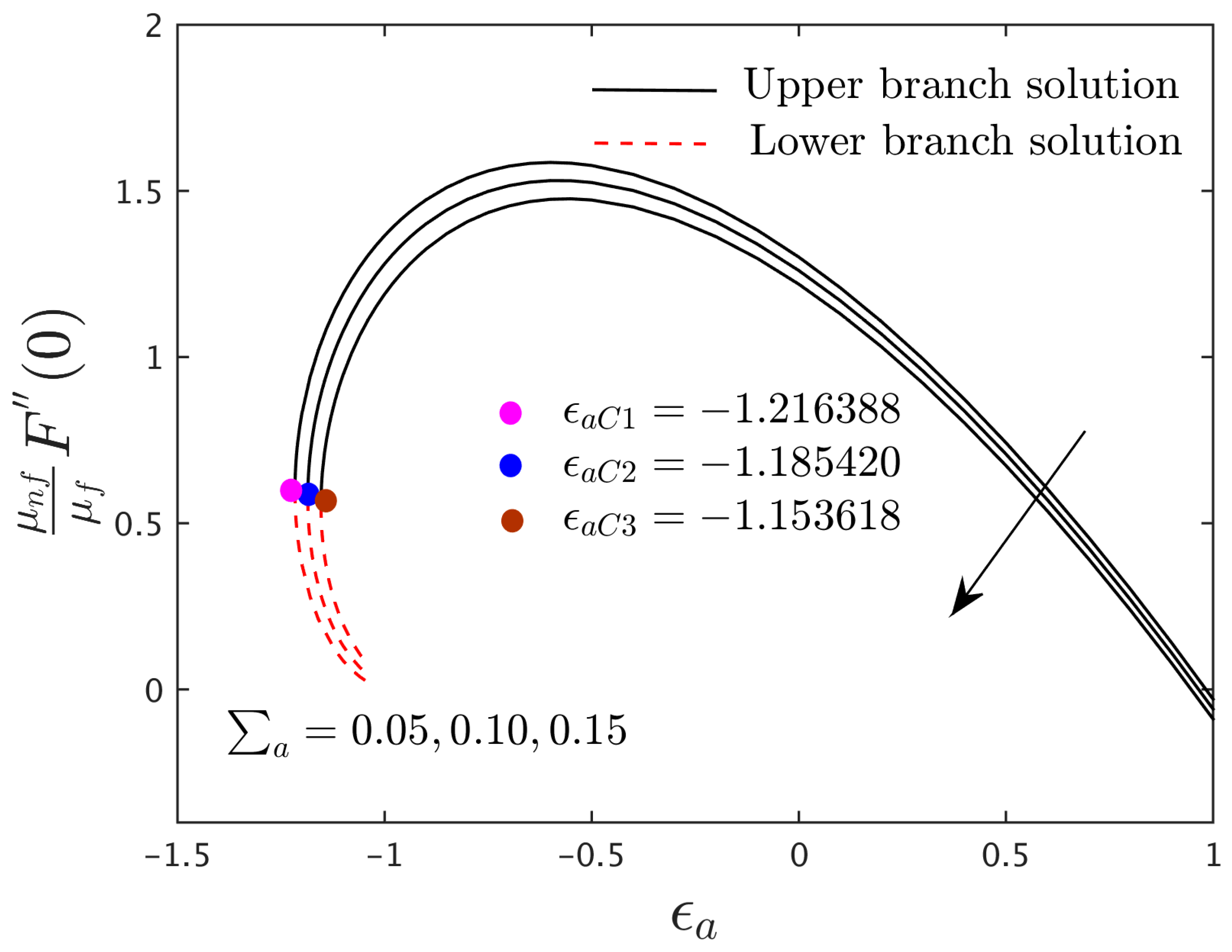
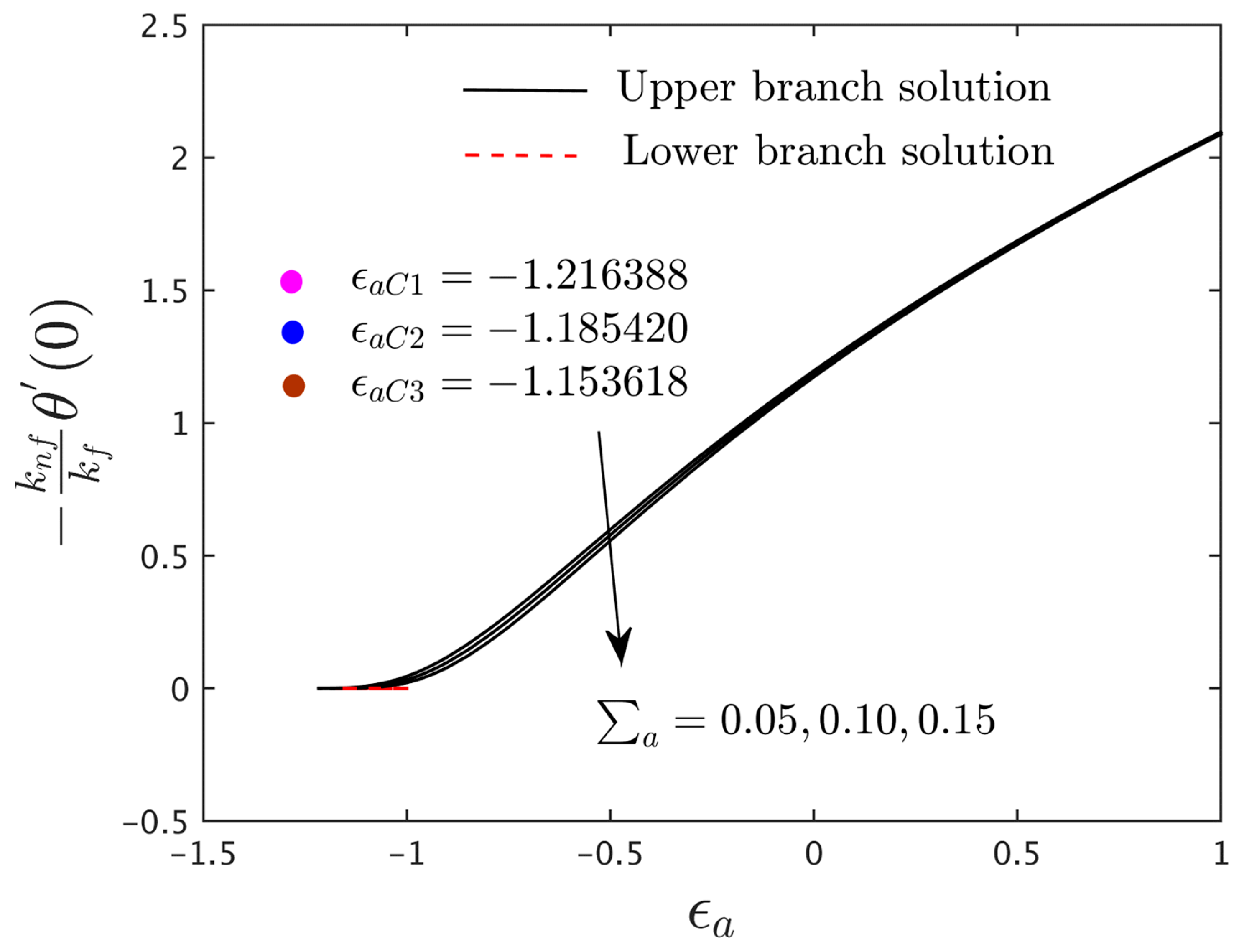
4.3. Research Physical Explanation of the Velocity and Induced Magnetic Profiles

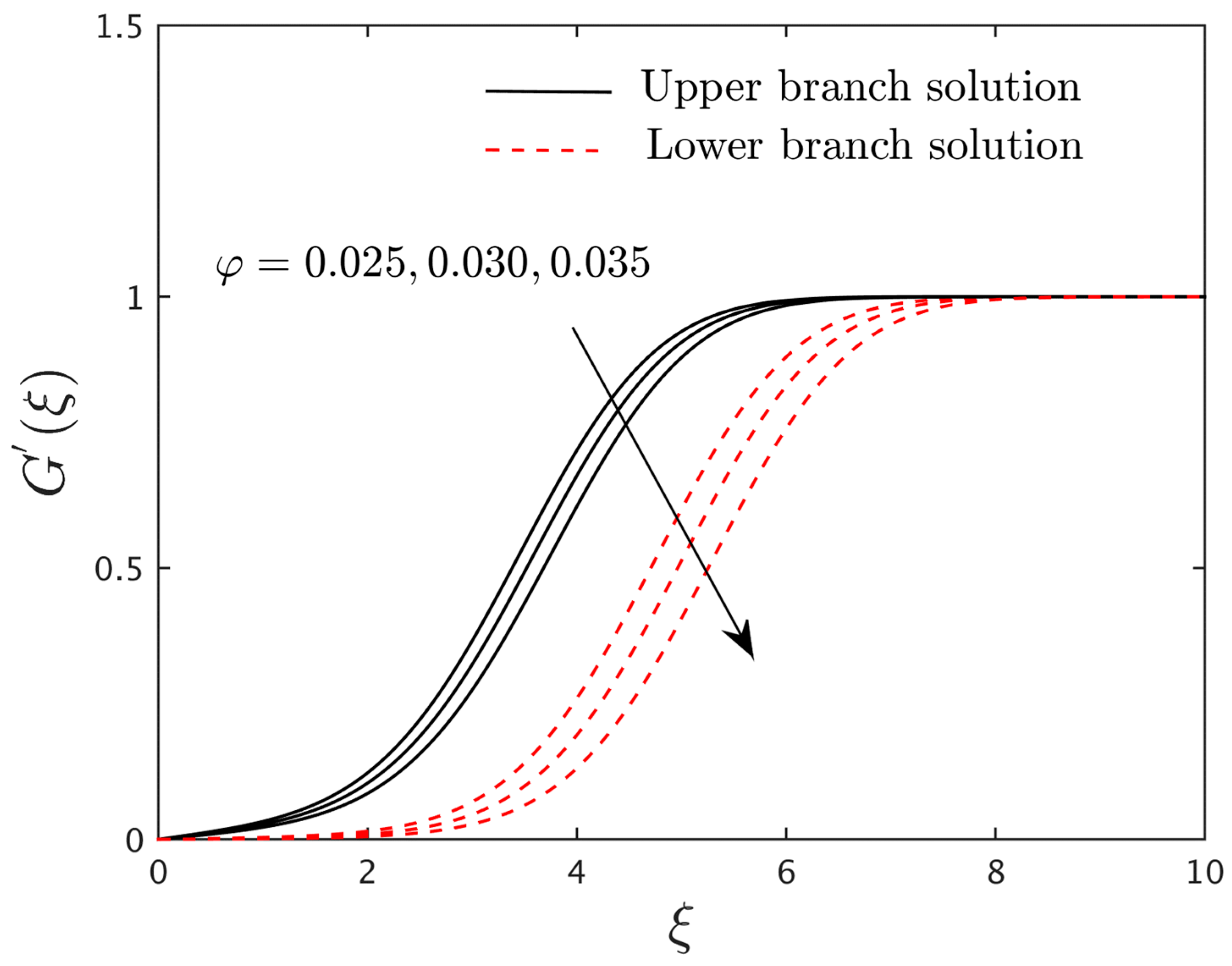

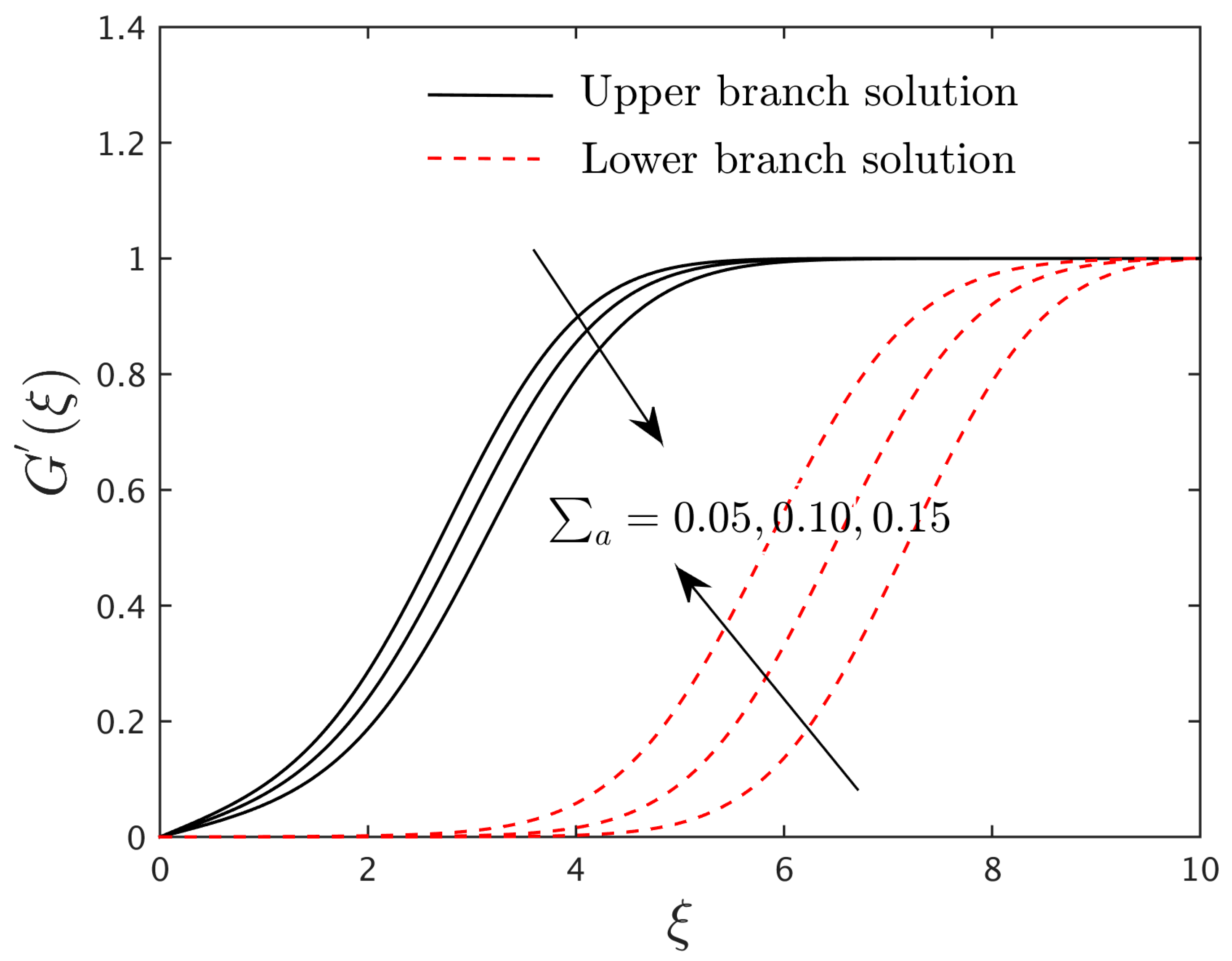
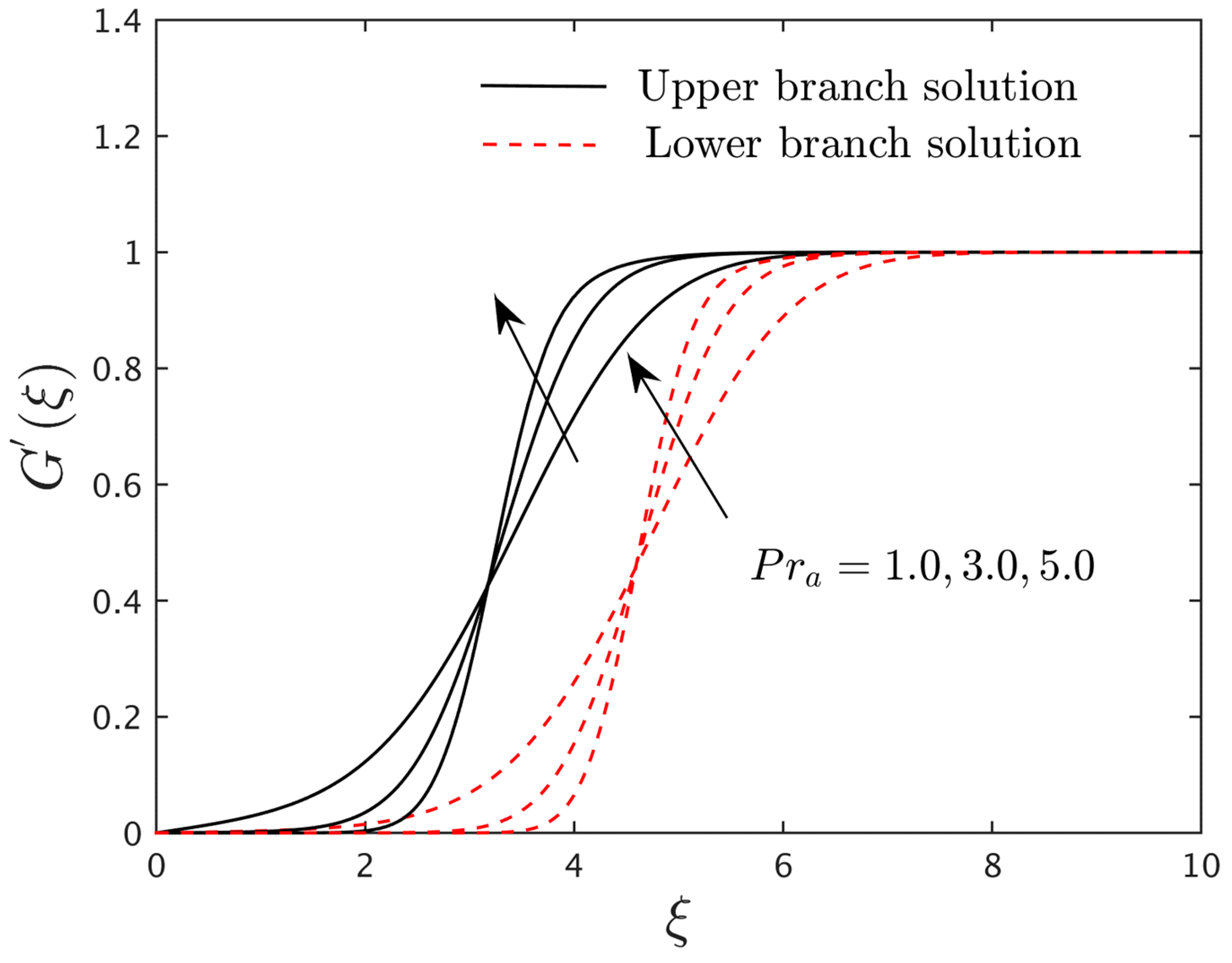
4.4. Research Physical Explanation of the Temperature and Concentration Profiles
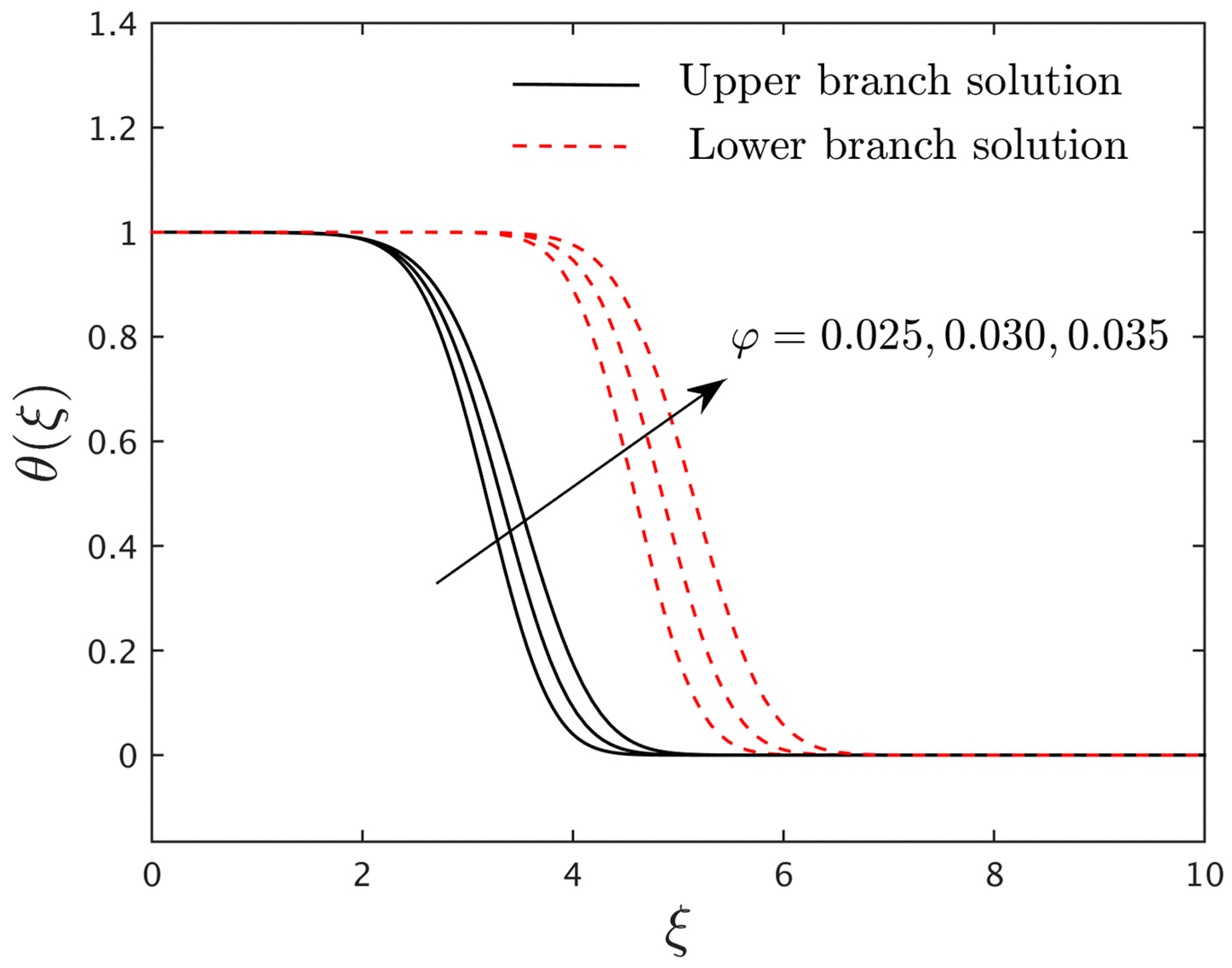
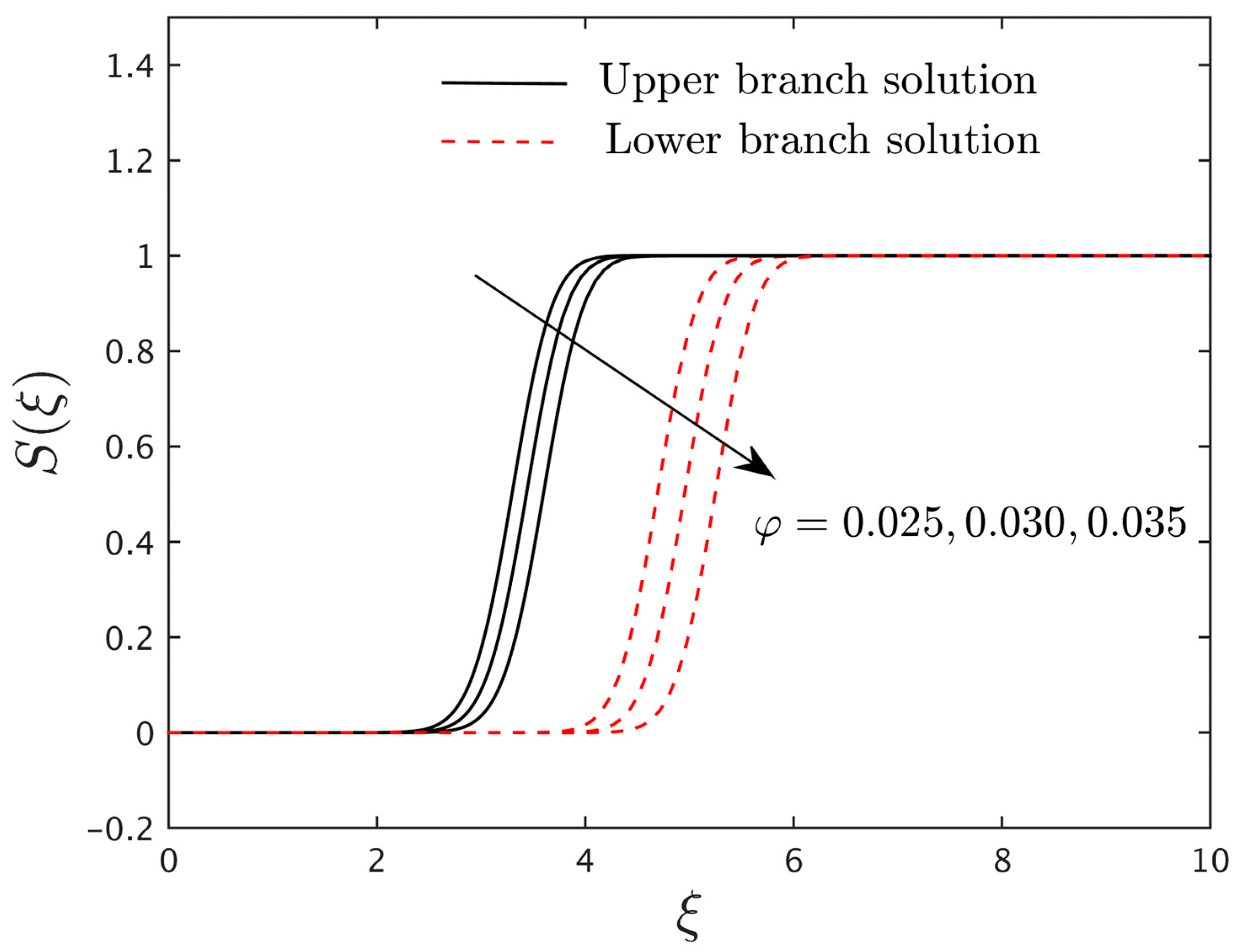
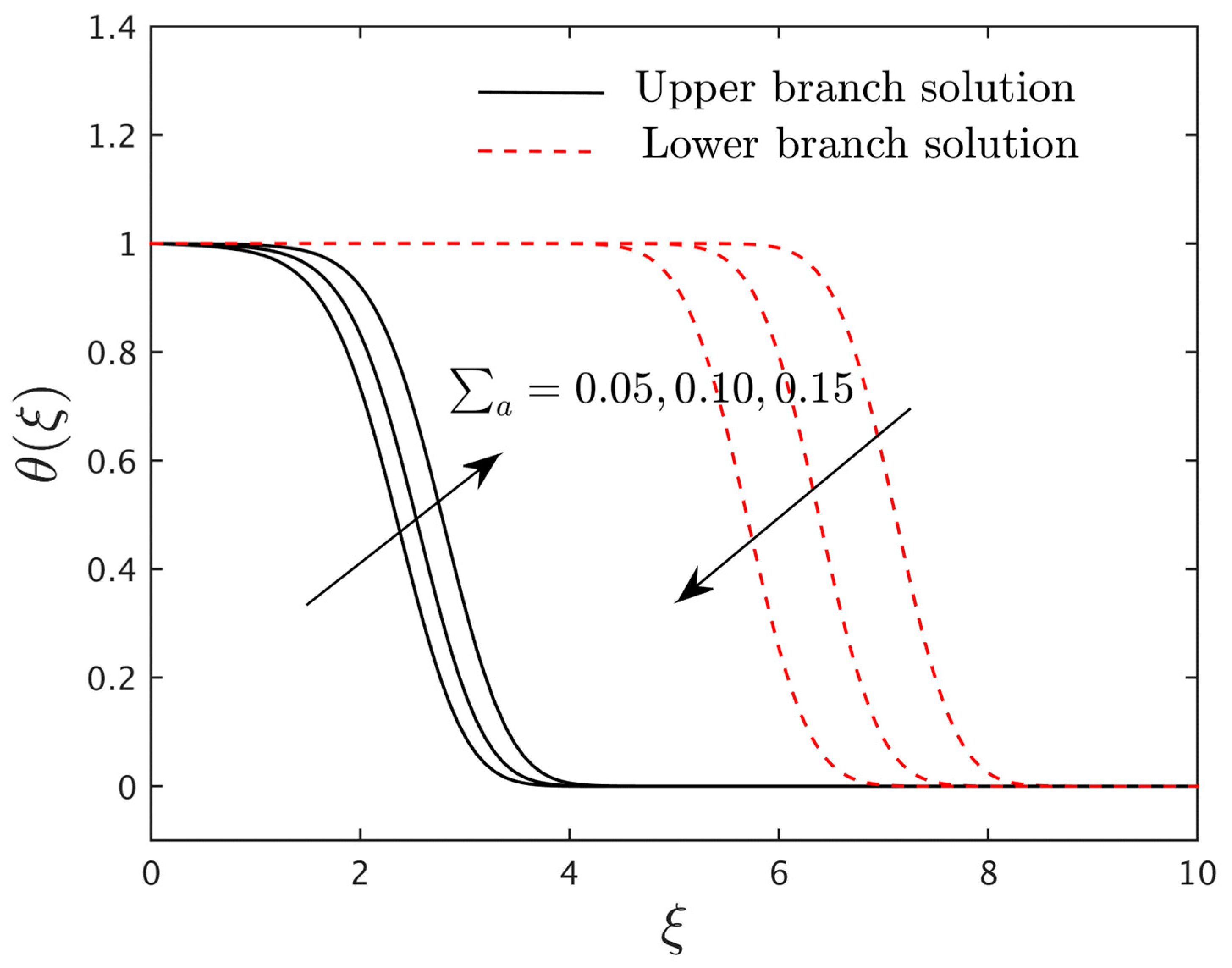

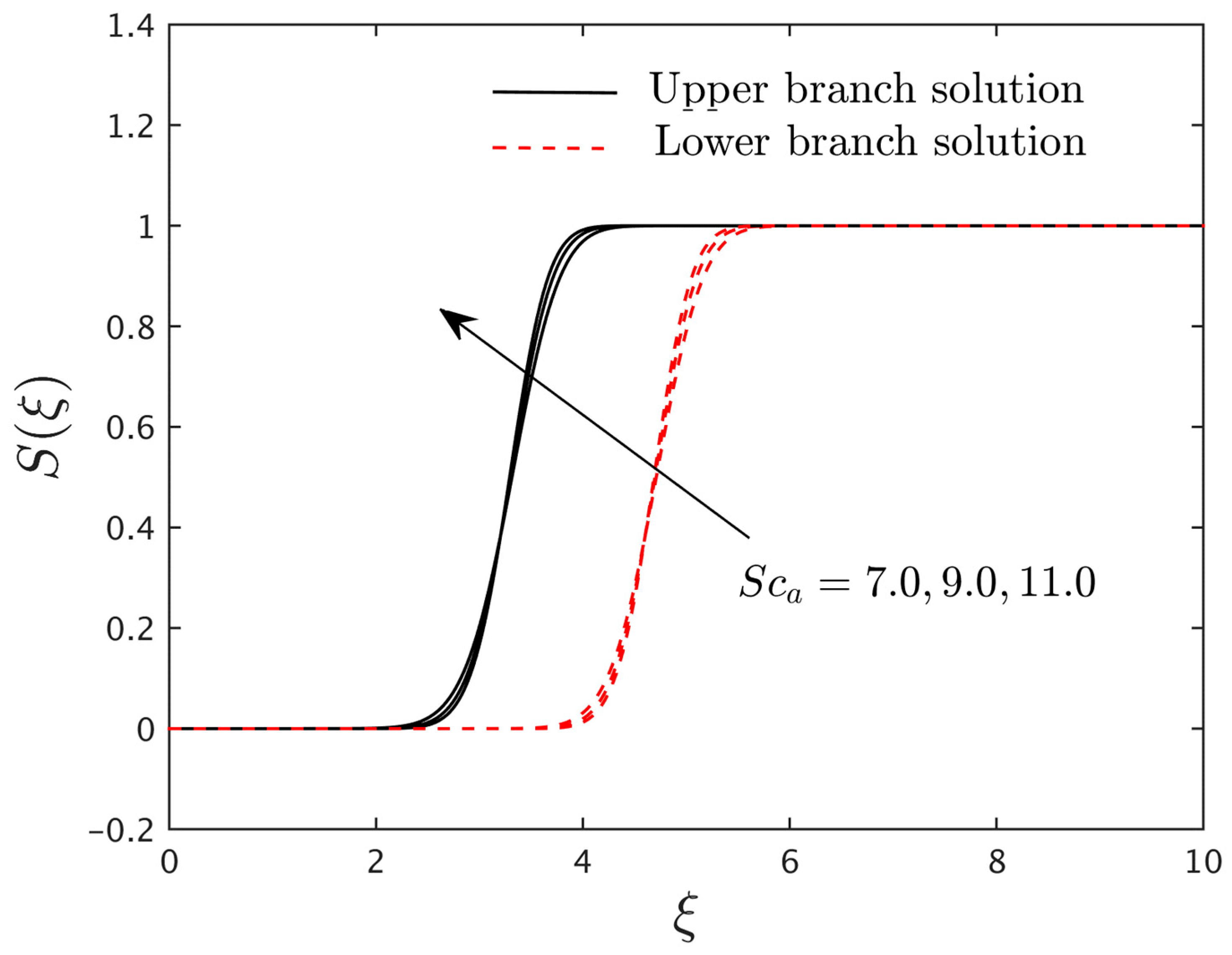
5. Conclusions
- The results for the shrinking sheet are found to be non-unique in contrast to their stretching sheet counterpart.
- The friction factor and heat transfer have boosted up for both solution branches as a result of the addition of graphene oxide nanoparticles to the base water fluid, and this impression is meaningfully accentuated as the nanoparticle volume fraction rises.
- For growing values of the nanoparticle volume fraction, the friction factors upsurge by almost 0.96% and 0.66% for the upper- and lower-branch solutions, respectively.
- The higher impact of the magnetic factor reduces the friction factor and the heat transfer for the branch of the upper solutions, while the patterns are altered for the second-branch solutions.
- The friction factor and heat transfer decline about to 9.58% and 69.4% for the respective branch of upper solutions due to higher impacts of magnetic parameter, while they escalate by almost 19.32% and 31.5% for the branch of lower solutions, respectively.
- The magnitude of the critical values upsurges as the values of escalates, while it shrinks with higher impacts of the magnetic factor.
- The heat-transport phenomenon uplifts up to 11.71% for the upper-branch solutions and 21.8% for the branch of lower-branch solutions owing to larger values of .
- For the growing values of the nanoparticle volume fraction, the fluid velocity, induced magnetic field, and concentration profiles decline for the two distinct branch solutions, but the temperature profiles abruptly develop.
- The concentration profiles are augmented for the two altered outcome branches due to some change values of the Schmidt number.
Author Contributions
Funding
Institutional Review Board Statement
Informed Consent Statement
Data Availability Statement
Conflicts of Interest
References
- Choi, S.U.; Eastman, J.A. Enhancing thermal conductivity of fluids with nanoparticles. In Proceedings of the 1995 International Mechanical Engineering Congress and Exhibition, San Francisco, CA, USA, 12–17 November 1995. [Google Scholar]
- Khan, W.A.; Pop, I. Boundary-layer flow of a nanofluid past a stretching sheet. Int. J. Heat Mass Transf. 2010, 53, 2477–2483. [Google Scholar] [CrossRef]
- Bachok, N.; Ishak, A.; Pop, I. Unsteady boundary-layer flow and heat transfer of a nanofluid over a permeable stretching/shrinking sheet. Int. J. Heat Mass Transf. 2012, 55, 2102–2109. [Google Scholar] [CrossRef]
- Gireesha, B.J.; Mahanthesh, B.; Gorla, R.S.R. Suspended Particle Effect on Nanofluid Boundary Layer Flow Past a Stretching Surface. J. Nanofluids 2014, 3, 267–277. [Google Scholar]
- Jain, D.S.; Rao, S.S.; Srivastava, A. Rainbow schlieren deflectometry technique for nanofluid-based heat transfer measurements under natural convection regime. Int. J. Heat Mass Transf. 2016, 98, 697–711. [Google Scholar]
- Rao, S.S.; Srivastava, A. Interferometric study of natural convection in a differentially-heated cavity with Al 2 O 3 –water based dilute nanofluids. Int. J. Heat Mass Transf. 2016, 92, 1128–1142. [Google Scholar]
- Makinde, O.D.; Mishra, S.R. On Stagnation Point Flow of Variable Viscosity Nanofluids Past a Stretching Surface with Radiative Heat. Int. J. Appl. Comput. Math. 2015, 3, 561–578. [Google Scholar] [CrossRef]
- Bhatti, M.M.; Mishra, S.R.; Abbas, T.; Rashidi, M.M. A mathematical model of MHD nanofluid flow having gyrotactic microorganisms with thermal radiation and chemical reaction effects. Neural Comput. Appl. 2018, 30, 1237–1249. [Google Scholar]
- Zuhra, S.; Khan, N.S.; Khan, M.A.; Islam, S.; Khan, W.; Bonyah, E. Flow and heat transfer in water based liquid film fluids dispensed with graphene nanoparticles. Results Phys. 2018, 8, 1143–1157. [Google Scholar] [CrossRef]
- Khan, U.; Zaib, A.; Shah, Z.; Baleanu, D.; Sherif, E.-S.M. Impact of magnetic field on boundary-layer flow of Sisko liquid comprising nanomaterials migration through radially shrinking/stretching surface with zero mass flux. J. Mater. Res. Technol. 2020, 9, 3699–3709. [Google Scholar] [CrossRef]
- Zaib, A.; Khan, U.; Khan, I.; Sherif, E.-S.M.; Nisar, K.S.; Seikh, A.H. Impact of Nonlinear Thermal Radiation on the Time-Dependent Flow of Non-Newtonian Nanoliquid over a Permeable Shrinking Surface. Symmetry 2020, 12, 195. [Google Scholar] [CrossRef] [Green Version]
- Nayak, B.; Mishra, S.R. Squeezing flow analysis of CuO–water and CuO–kerosene-based nanofluids: A comparative study. Pramana J. Phys. 2021, 95, 29. [Google Scholar]
- Waini, I.; Khan, U.; Zaib, A.; Ishak, A.; Pop, I. Inspection of TiO2-CoFe2O4 nanoparticles on MHD flow toward a shrinking cylinder with radiative heat transfer. J. Mol. Liq. 2022, 361, 119615. [Google Scholar] [CrossRef]
- Glauert, M.B. The boundary layer on a magnetized plate. J. Fluid Mech. 1962, 12, 625–638. [Google Scholar] [CrossRef]
- Takhar, H.; Chamkha, A.; Nath, G. Unsteady flow and heat transfer on a semi-infinite flat plate with an aligned magnetic field. Int. J. Eng. Sci. 1999, 37, 1723–1736. [Google Scholar]
- Alom, M.M.; Rafiqul, I.M.; Rahman, F. Steady heat and mass transfer by mixed convection flow from a vertical porous plate with induced magnetic field, constant heat and mass fluxes. Thammasat. Int. J. Sci. Technol. 2008, 13, 1–13. [Google Scholar]
- Ahmed, S.; Chamkha, A.J. Effects of chemical reaction, heat and mass transfer and radiation on MHD flow along a vertical porous wall in the present of induced magnetic field. Int. J. Ind. Math. 2009, 2, 245–261. [Google Scholar]
- Bég, O.A.; Bakier, A.; Prasad, V.; Zueco, J.; Ghosh, S. Nonsimilar, laminar, steady, electrically-conducting forced convection liquid metal boundary layer flow with induced magnetic field effects. Int. J. Therm. Sci. 2009, 48, 1596–1606. [Google Scholar]
- Ghosh, S.K.; Bég, O.A.; Zueco, J. Hydromagnetic free convection flow with induced magnetic field effects. Meccanica 2009, 45, 175–185. [Google Scholar]
- Ali, F.M.; Nazar, R.; Arifin, N.; Pop, I. MHD stagnation-point flow and heat transfer towards stretching sheet with induced magnetic field. Appl. Math. Mech. 2011, 32, 409–418. [Google Scholar]
- Gireesha, B.; Mahanthesh, B.; Shivakumara, I.; Eshwarappa, K. Melting heat transfer in boundary layer stagnation-point flow of nanofluid toward a stretching sheet with induced magnetic field. Eng. Sci. Technol. Int. J. 2016, 19, 313–321. [Google Scholar] [CrossRef] [Green Version]
- Sheikholeslami, M.; Rokni, H.B. Nanofluid two phase model analysis in existence of induced magnetic field. Int. J. Heat Mass Transf. 2017, 107, 288–299. [Google Scholar] [CrossRef]
- Hou, E.; Hussain, A.; Rehman, A.; Baleanu, D.; Nadeem, S.; Matoog, R.T.; Khan, I.; Sherif, E.-S.M. Entropy generation and induced magnetic field in pseudoplastic nanofluid flow near a stagnant point. Sci. Rep. 2021, 11, 23736. [Google Scholar] [CrossRef] [PubMed]
- Williams, W.R.; Stenzel, M.T.; Song, X.; Schmidt, L.D. Bifurcation behaviour in homogeneous-heterogeneous combustion. I. Experimental results over platinum. Combust. Flame 1991, 84, 277–291. [Google Scholar] [CrossRef]
- Williams, W.R.; Zhao, J.; Schmidt, L.D. Ignition and extinction of surface and homogeneous oxidation of NH3 and CH4. AIChE J. 1991, 37, 641–649. [Google Scholar] [CrossRef]
- Song, X.; Williams, W.R.; Schmidt, L.D.; Aris, R. Bifurcation behaviour in homogeneous-heterogeneous combustion. II. Computations for stagnation-point flow. Combust. Flame 1991, 84, 292–311. [Google Scholar] [CrossRef]
- Song, X.; Schmidt, L.; Aris, R. Steady states and oscillations in homogeneous—Heterogeneous reaction systems. Chem. Eng. Sci. 1991, 46, 1203–1215. [Google Scholar] [CrossRef]
- Song, X.; Schmidt, L.D.; Aris, R. The ignition criteria for stagnation-point flow: Semenov–Frank–Kamenetskii or van’t Hoff. Combust. Sci. Technol. 1991, 75, 311–331. [Google Scholar] [CrossRef]
- Ikeda, H.; Libby, P.A.; Williams, F.A.; Sato, J. Catalytic combustion of hydrogen-air mixtures in stagnation flows. Combust. Flame 1993, 93, 138–148. [Google Scholar] [CrossRef]
- Chaudhary, M.A.; Merkin, J.H. A simple isothermal model for homogeneous-heterogeneous reactions in boundary-layer flow. I Equal diffusivities. Fluid Dyn. Res. 1995, 16, 311–333. [Google Scholar] [CrossRef]
- Chaudhary, M.A.; Merkin, J.H. A simple isothermal model for homogeneous-heterogeneous reactions in boundary-layer flow. II Different diffusivities for reactant and autocatalyst. Fluid Dyn. Res. 1995, 16, 335–359. [Google Scholar] [CrossRef]
- Bachok, N.; Ishak, A.; Pop, I. On the stagnation-point flow towards a stretching sheet with homogeneous–heterogeneous reactions effects, Commun. Nonlinear Sci. Numer. Simulat. 2011, 16, 4296–4302. [Google Scholar] [CrossRef]
- Ibrahim, W. The effect of induced magnetic field and convective boundary condition on MHD stagnation point flow and heat transfer of upper-convected Maxwell fluid in the presence of nanoparticle past a stretching sheet. Propuls. Power Res. 2016, 5, 164–175. [Google Scholar] [CrossRef] [Green Version]
- Mahanthesh, B.; Gireesha, B.; Athira, P. Radiated flow of chemically reacting nanoliquid with an induced magnetic field across a permeable vertical plate. Results Phys. 2017, 7, 2375–2383. [Google Scholar] [CrossRef]
- Jha, B.K.; Aina, B. Impact of induced magnetic field onmagnetohydrodynamic (MHD) natural convection flow in a vertical annular micro-channel in the presence of radial magnetic field. Propuls. Power Res. 2018, 7, 171–181. [Google Scholar] [CrossRef]
- Goud, B.S.; Kumar, P.P.; Malga, B.S. Induced magnetic field effect on MHD free convection flow in nonconducting and conducting vertical microchannel walls. Heat Transf. 2021, 51, 2201–2218. [Google Scholar] [CrossRef]
- Kumar, D. Radiation effect on magnetohydrodynamic flow with induced magnetic field and Newtonian heating/cooling: An analytic approach. Propuls. Power Res. 2021, 10, 303–313. [Google Scholar] [CrossRef]
- Merkin, J. A model for isothermal homogeneous-heterogeneous reactions in boundary-layer flow. Math. Comput. Model. 1996, 24, 125–136. [Google Scholar] [CrossRef]
- Ho, C.J.; Chen, M.W.; Li, Z.W. Effect of natural convection heat transfer of nanofluid in an enclosure due to uncertainties of viscosity and thermal conductivity. In Proceedings of the ASME-JSME Thermal Engineering Summer Heat Transfer Conference Vancouver, Vancouver, BC, Canada, 8–12 July 2007; pp. 833–841. [Google Scholar]
- Chu, Y.-M.; Nisar, K.S.; Khan, U.; Kasmaei, H.D.; Malaver, M.; Zaib, A.; Khan, I. Mixed Convection in MHD Water-Based Molybdenum Disulfide-Graphene Oxide Hybrid Nanofluid through an Upright Cylinder with Shape Factor. Water 2020, 12, 1723. [Google Scholar] [CrossRef]
- Khan, U.; Zaib, A.; Abu Bakar, S.; Ishak, A. Stagnation-point flow of a hybrid nanoliquid over a non-isothermal stretching/shrinking sheet with characteristics of inertial and microstructure. Case Stud. Therm. Eng. 2021, 26, 101150. [Google Scholar] [CrossRef]
- Khan, U.; Zaib, A.; Ishak, A.; Waini, I.; Raizah, Z.; Prasannakumara, B.C.; Galal, A.M. Dynamics of bio-convection Agrawal axisymmetric flow of water-based Cu-TiO2 hybrid nanoparticles through a porous moving disk with zero mass flux. Chem. Phys. 2022, 561, 111599. [Google Scholar] [CrossRef]
- Weidman, P.; Kubitschek, D.; Davis, A. The effect of transpiration on self-similar boundary layer flow over moving surfaces. Int. J. Eng. Sci. 2006, 44, 730–737. [Google Scholar] [CrossRef]
- Khan, U.; Waini, I.; Ishak, A.; Pop, I. Unsteady hybrid nanofluid flow over a radially permeable shrinking/stretching surface. J. Mol. Liq. 2021, 331, 115752. [Google Scholar] [CrossRef]
- Ridha, A.; Curie, M. Aiding flows non-unique similarity solutions of mixed-convection boundary-layer equations. Z. Angew. Math. Phys. 1996, 47, 341–352. [Google Scholar] [CrossRef]
- Ishak, A.; Merkin, J.H.; Nazar, R.; Pop, I. Mixed convection boundary layer flow over a permeable vertical surface with prescribed wall heat flux. Z. Angew. Math. Phys. 2008, 59, 100–123. [Google Scholar] [CrossRef]
- Wang, C. Stagnation flow towards a shrinking sheet. Int. J. Non-linear Mech. 2008, 43, 377–382. [Google Scholar] [CrossRef]

| Physical Properties | Water | GO |
|---|---|---|
| 0.613 | 5000 | |
| 4179 | 717 | |
| 997.1 | 1800 |
| Wang [47] | Upper-Branch Solution | |
|---|---|---|
| 0.0 | 1.232588 | 1.232587642 |
| 0.1 | 1.14656 | 1.146560982 |
| 0.2 | 1.05113 | 1.051129966 |
| 0.5 | 0.71330 | 0.713294952 |
| 1.0 | 0.00000 | −0.000000000 |
| 2.0 | −1.88731 | −1.887306599 |
| 5.0 | −10.26475 | −10.26474925 |
| Wang [47] | Upper-Branch Solution | |
|---|---|---|
| −0.25 | 1.40224 | 1.402240753 |
| −0.5 | 1.49567 | 1.495669735 |
| −0.75 | 1.48930 | 1.489298207 |
| −1.0 | 1.32882 | 1.328816725 |
| −1.15 | 1.08223 | 1.082230837 |
| −1.2465 | 0.55430 | 0.554281597 |
| Upper-Branch Solution | Lower-Branch Solution | ||
|---|---|---|---|
| 0.025 | 0.05 | 0.78934318 | 0.36502475 |
| 0.030 | - | 0.79695011 | 0.36739439 |
| 0.035 | - | 0.80463902 | 0.36979632 |
| 0.025 | 0.03 | 0.87294876 | 0.30592379 |
| - | 0.05 | 0.78934318 | 0.36502475 |
| - | 0.07 | 0.66111358 | 0.46876468 |
| Upper-Branch Solution | Lower-Branch Solution | ||
|---|---|---|---|
| 0.025 | 0.05 | 0.000046484161 | 0.00000000032 |
| 0.030 | - | 0.000051925546 | 0.00000000039 |
| 0.035 | - | 0.000057853046 | 0.00000000046 |
| 0.025 | 0.03 | 0.000151908360 | 0.00000000001 |
| - | 0.05 | 0.000046484161 | 0.00000000032 |
| - | 0.07 | 0.000004646659 | 0.00000002552 |
Publisher’s Note: MDPI stays neutral with regard to jurisdictional claims in published maps and institutional affiliations. |
© 2022 by the authors. Licensee MDPI, Basel, Switzerland. This article is an open access article distributed under the terms and conditions of the Creative Commons Attribution (CC BY) license (https://creativecommons.org/licenses/by/4.0/).
Share and Cite
Khan, U.; Zaib, A.; Ishak, A.; Alotaibi, A.M.; Elattar, S.; Pop, I.; Abed, A.M. Impact of an Induced Magnetic Field on the Stagnation-Point Flow of a Water-Based Graphene Oxide Nanoparticle over a Movable Surface with Homogeneous–Heterogeneous and Chemical Reactions. Magnetochemistry 2022, 8, 155. https://doi.org/10.3390/magnetochemistry8110155
Khan U, Zaib A, Ishak A, Alotaibi AM, Elattar S, Pop I, Abed AM. Impact of an Induced Magnetic Field on the Stagnation-Point Flow of a Water-Based Graphene Oxide Nanoparticle over a Movable Surface with Homogeneous–Heterogeneous and Chemical Reactions. Magnetochemistry. 2022; 8(11):155. https://doi.org/10.3390/magnetochemistry8110155
Chicago/Turabian StyleKhan, Umair, Aurang Zaib, Anuar Ishak, Abeer M. Alotaibi, Samia Elattar, Ioan Pop, and Ahmed M. Abed. 2022. "Impact of an Induced Magnetic Field on the Stagnation-Point Flow of a Water-Based Graphene Oxide Nanoparticle over a Movable Surface with Homogeneous–Heterogeneous and Chemical Reactions" Magnetochemistry 8, no. 11: 155. https://doi.org/10.3390/magnetochemistry8110155






